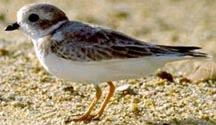Assateague
Island National Seashore

|
|
| Assateague
Island National Seashore is an extremely important nesting area for the
piping plover. During spring and summer, these birds breed in northern
parts of the US and Canada. They migrate south to coastal areas along
the Gulf of Mexico when fall season arrives.
The Piping Plover's nesting area has become smaller over the years since many coastal beaches have been developed as a result of human population growth. Foxes, gulls, raccoons, skunks, and other animals prey on piping plover eggs and chicks. When predators come close, the parents may attempt to attract attention by acting as if they have a broken wing. Certain areas along Assateague Island National Seashore have been the focus of the National Park Service and Fish & Wildlife Service when it comes to protecting these sensitive birds. Since too much human disturbance (either on foot or vehicles) can cause the birds to abandon their nests, some beach areas have been deemed "off limits" when it comes to human presence. On beaches where vehicles are allowed, the young chicks often get stuck in deep tire tracks the vehicles leave. Piping plovers eat crustaceans, mollusks, larvae, beetles, and other invertebrates which they extract from the sand of Assateague's beaches. The Atlantic Coast Population of Piping Plovers is estimated to be about 1,372 breeding pairs. This group is considered to be a threatened species, and the Great Lakes population is listed as endangered. |
|
|
|
PIPING PLOVER
|
|
(Charadrius
melodus)
|
|
|
